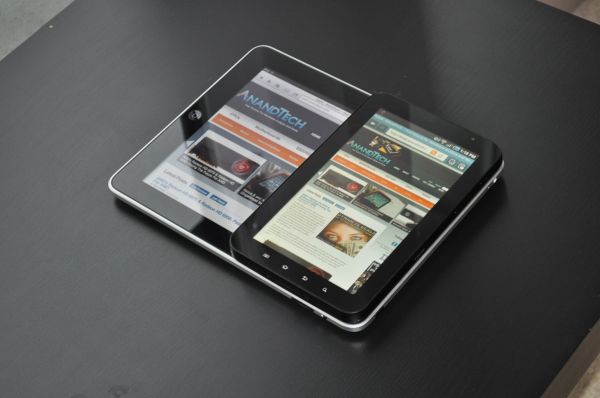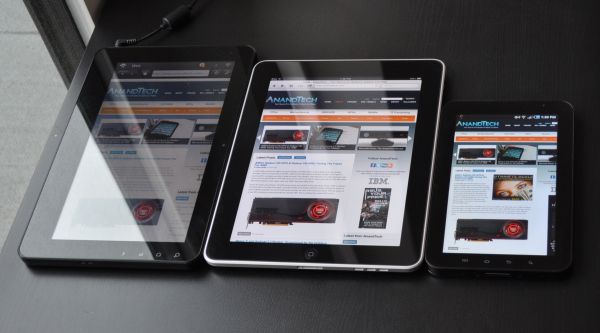Samsung Galaxy Tab - The AnandTech Review
by Vivek Gowri on December 23, 2010 9:48 AM ESTSamsung Galaxy Tab - Size Really Does Matter
The Galaxy Tab is almost exactly half the size of the iPad.
So the Galaxy Tab, as one of the first 7” tablets to release, brings up a new concern in the tablet space - how much does screen size change things? This is the first real 7” tablet I’ve played with for any length of time, but my first reaction when I pulled the Galaxy Tab out of the box was “dang, this thing is a lot smaller than I expected”. It’s literally half the size of the 9.7” iPad, dimensionally. It’s interesting to see two supposedly competitive devices have such different form factors, completely at odds with how the notebook market works.
The sizing thing is going to be a big deal for tablets going forward, and I think eventually we’ll see the market split into two or three segments based on size. It looks like some companies are already choosing one camp or the other; Apple appears staunchly in the 10” camp after Steve Jobs ripped on the entire 7” form factor, RIM is going 7” for its PlayBook, Dell started with 5” and are adding 7” and 9” models, HP took the middle road with its 8.9” slate, Samsung is adding a 10” Galaxy Tab early next year. So we’re going to be seeing tons of both 7” and 10” form factors on the market.
So why choose one form factor over the other? They’ll likely have similar internal hardware and the same WSVGA resolution on differently sized screens, so it won’t be on specs, and based on the current device pricing, I don’t expect that to be terribly different either. So, really, it comes down to whichever suits your use cases better.
Three tablets, three screen sizes. Pick your form factor wisely.
Honestly, here’s what I found: it’s more comfortable to use the 7” tablet in portrait mode, whereas it’s easier to use the 10”ers in landscape. This is true for both the 4:3 iPad or any of the 16:9 10” widescreen tablets. Part of it is in the keyboard - the 7” portrait keyboard is just comfortable enough to use with two thumbs, whereas in landscape its a bit too wide. The 10” has the opposite problem - too wide for two thumbs and too narrow for normal typing in portrait mode, but just about perfect with two handed typing in landscape. The difference is that with the 7” tablet, you can use it like a large smartphone, whereas the 10” tablets are more suited for use on a desk or table. The iPad and other 10” tablets are better as standalone netbook replacements, while the 7” Galaxy Tab almost feel like a device that’s meant to be carried in addition to a notebook.












97 Comments
View All Comments
trip1ex - Thursday, December 23, 2010 - link
because tablet software is made for the tablet while the software that is run on netbooks is developed for machines that are much more powerful with bigger screens and keyboards.
That's a big reason why netbooks are a crappy user experience and the experience on the iPad is a great user experience.
vld - Thursday, December 23, 2010 - link
How about the Archos 70 or 101 internet tablets? Direct comparison is definitely possible with the Froyo2.2 update from their web page.tipoo - Thursday, December 23, 2010 - link
Do they have those for testing? I'm defiantly interested in those, with Froyo and potentially Honeycomb plus jailbreaking those look like solid contenders for a much entry lower price.Rick83 - Thursday, December 23, 2010 - link
Got a 101 for my parents for christmas...it's certainly not in the same league as the iPad and G-Tab, but at the price it doesn't have to be. And at least you get hdmi out and a usb host (with an extra adapter on the 70).If Archos could spare 5p for some marketing, they'd be a major player.... Sadly, their finances are a bit strained....And they're French :-O
Also, I continuously fail to see why people pay laptop money for sub-netbook hardware, just because someone went and threw the keyboard away. It's pretty ridiculous....At their pricepoints the Archos tablets are sensible products - slightly more portable than a netbook, and direct interaction UIs (ie touchscreens), while priced in the same region. The expensive tabs don't do significantly more, but the extra cost is just astronomical. Even 50% more, so in the 450-500 euro/$ range would be expensive....
TareX - Thursday, December 23, 2010 - link
It was a nice attempt on Samsung's behalf, but I knew I would be waiting for the Honeycomb 8.9" Tegra 2 tablets instead, like the LG Optimus Pad...rs2 - Thursday, December 23, 2010 - link
"So what then? It’s the software. Or, to be more specific, Froyo. It’s too similar to a smartphone right now, too much of the same experience repeated on a 200% scale."...and the iPad is the same experience as the iPhone on a 400% scale. You can't place the Galaxy Tab second to the iPad just for having the same problem as the iPad.
robco - Thursday, December 23, 2010 - link
That would be true of the first version of the software. It was a bit of a kludge. Now we know that the iPad was actually conceived first, so you could say the iPhone is a scaled down iPad.But Apple did create a lot of new UI widgets specifically designed to take advantage of the larger screen real estate. Froyo doesn't have this. Apple released a new version of the SDK with an iPad emulator, Samsung had to put their own together without Google. I'm not holding out much hope for a good standard UI on Android either. Google is a great engineering company, but they miss out on the "soft" skills. Apple is good at both. I know Google has UI designers, but it doesn't appear that they listen to them very much. They seem to be more with Android over their other products, but that's not saying a whole lot. iOS looks clean and professional, Android does not.
I think in the end, people want a clean, polished product where the underlying technology isn't in your face, but is useful and makes it easy to get things done. MS is learning this lesson. Google needs to.
VivekGowri - Thursday, December 23, 2010 - link
@rs2 - if you read my software section, I said exactly that - having a scaled up OS never held the iPad back, so it's not something I can hold against the Galaxy Tab. What I can hold against the Galaxy Tab is that there are basically no apps, first party or otherwise, that take advantage of the larger screen size, other than the three or four apps that Samsung put in afterwards (Mail, Calendar, Contacts, etc). Apple basically changed every core app on the iPad to use that screen real estate, and they had more than a few high profile 3rd party apps out for the iPad - ABC player, NYT, BBC, etc etc. I don't doubt that Google will get there, probably with Honeycomb, but until then, it's a legitimate problem.Rick83 - Friday, December 24, 2010 - link
Actually, there are both screen size and resolution variables that apps can read and adopt to, which only recently have been expanded to cover up to 10" (in 2.3) and 7" (in 2.2).So the issue with the apps is just a matter of time.
Also, tablets are much like TVs: consumption devices. You set the channel/insert your media and lean back. (Unless you belong to the group of idiots that mistake the devices for portable gaming systems...) In this scenarion UI scaling isn't as important as it may seem. Actually, even on my 5" 800x480 tablet, individual features are very small, and I prefer the easier reading on the big screen of the Samsung.
Voldenuit - Thursday, December 23, 2010 - link
>I’m not much of a Swype guyHeretic!!!~ :P